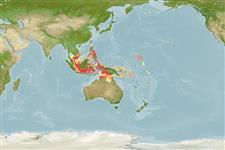Classification / Names
Nomi Comuni | Sinonimi | Catalog of Fishes(Genere, Specie) | ITIS | CoL | WoRMS | Cloffa
>
Acanthuriformes (Surgeonfishes) >
Leiognathidae (Slimys, slipmouths, or ponyfishes) > Gazzinae
Etymology: laterofenestra: Name from Latin 'lateralis' meaning lateral/side and 'fenestra' meaning window, referring for its expansive transluscent lateral flank patch in males; noun in apposition..
Environment: milieu / climate zone / depth range / distribution range
Ecologia
marino demersale; distribuzione batimetrica 0 - 86 m (Ref. 59114). Tropical
Western Pacific: Philippines, Malaysia, Indonesia, Australia. .
Size / Peso / Age
Maturity: Lm ? range ? - ? cm
Max length : 12.8 cm SL maschio/sesso non determinato; (Ref. 59114)
Short description
Chiavi di identificazione | Morfologia | Morfometria
Spine dorsali (totale) : 8; Raggi dorsali molli (totale) : 16; Spine anali: 3; Raggi anali molli: 14; Vertebre: 23. The males of this species are distinguished from all its congeners by possessing an expansive cornucopia-shaped translucent lateral flank patch, while both sexes can be further distinguished from P. elongatus and P. rivulatus, by the more or less bullet-shaped flank patch; a deeper body 34.4-39.2 (vs. 12.5-29.7% of SL); and, vermiculate pigmentation pattern on the upper flank with thin wavy lines forming semi-circles and oval shapes (vs. larger rounded blotches). Both sexes of this species differ from P. leuciscus and P. klunzingeri, by the triangular flank patch; absence of a markedly elongate second dorsal-fin spine; and the vermiculate pigmentation pattern on the upper flank, with thin wavy lines forming semi-circles and oval shapes (vs. speckled). Adults of both sexes of also grow to a larger size than congeners, except P. leuciscus (Ref. 59114).
Life cycle and mating behavior
Maturities | Riproduzione | Spawnings | Egg(s) | Fecundities | Larve
Sparks, J.S. and P. Chakrabarty, 2007. A new species of ponyfish (Teleostei: Leiognathidae: Photoplagios) from the Philippines. Copeia 2007(3):622-629. (Ref. 59114)
IUCN Red List Status (Ref. 130435)
Threat to humans
Harmless
Human uses
Pesca: commerciale
Strumenti
Special reports
Download XML
Fonti Internet
Estimates based on models
Preferred temperature (Ref.
123201): 27.2 - 28.9, mean 28.5 °C (based on 42 cells).
Phylogenetic diversity index (Ref.
82804): PD
50 = 0.5010 [Uniqueness, from 0.5 = low to 2.0 = high].
Bayesian length-weight: a=0.01862 (0.00823 - 0.04215), b=2.97 (2.78 - 3.16), in cm total length, based on LWR estimates for this (Sub)family-body shape (Ref.
93245).
Trophic level (Ref.
69278): 3.4 ±0.4 se; based on size and trophs of closest relatives
Resilienza (Ref.
120179): Alto, tempo minimo di raddoppiamento della popolazione meno di 15 mesi (Preliminary K or Fecundity.).
Fishing Vulnerability (Ref.
59153): Low vulnerability (10 of 100).
